Sending a decent email with attractive headings and messages, but whim at email sign offs is a pretty common event. When composing emails with a significant, precise start is a preference, avoiding an email signature or greeting is a common scenario in email sending.
A statistic shows at least 78 percent of respondent in the UK agree to have a branded signature on their email. So, the email signature at the end of an email is an important part.
On the same side, proper endings for emails with signatures and addressing with appropriate words are the requirements to be gladly accepted by the receiver.
Let’s find out how to sign off an email in the later part.
Table of contents
- What is a sign off in an email?
- Importance of email sign offs
- Different ways to sign off an email with examples
- Email sign offs to avoid
- Best practices on email sign offs
- Email sign off examples
- FAQs
- Wrap up
What is a sign off in an email?
Email sign-off refers to the email closing phrases that come at the end section. Practically, these phrases come before the name and email signature as an email closing salutation. For example-
- ‘’Thanks for reaching out’’
- ‘’Thank you for your message’’
- ‘’With best regards’’
Signing off an email with an appropriate message increases the possibility of opening an email, leaves a bold impression on your email, and helps you get a positive response at the same time. They are an essential part of business communication or any formal conversation to nurture email etiquette.
Importance of email sign offs: How to sign off an email?
Whether it’s email opening lines or endings for emails, it’s equally essential to maintain the right email etiquette. Putting an end or signing off an email is not difficult to do, but your thought process needs to work overtime to create better salutations for emails. Most of us don’t pay much attention to this section. However, it’s important to end an email appropriately with a clear and accurate message.
A statistic shows that the most responded good closing for emails are
- Thanks in advance
- Thanks
- Thank you
“Thanks in advance”; this is the most used email sign-off form. See the statistics below on which sign-off form has been performing better when sending emails.
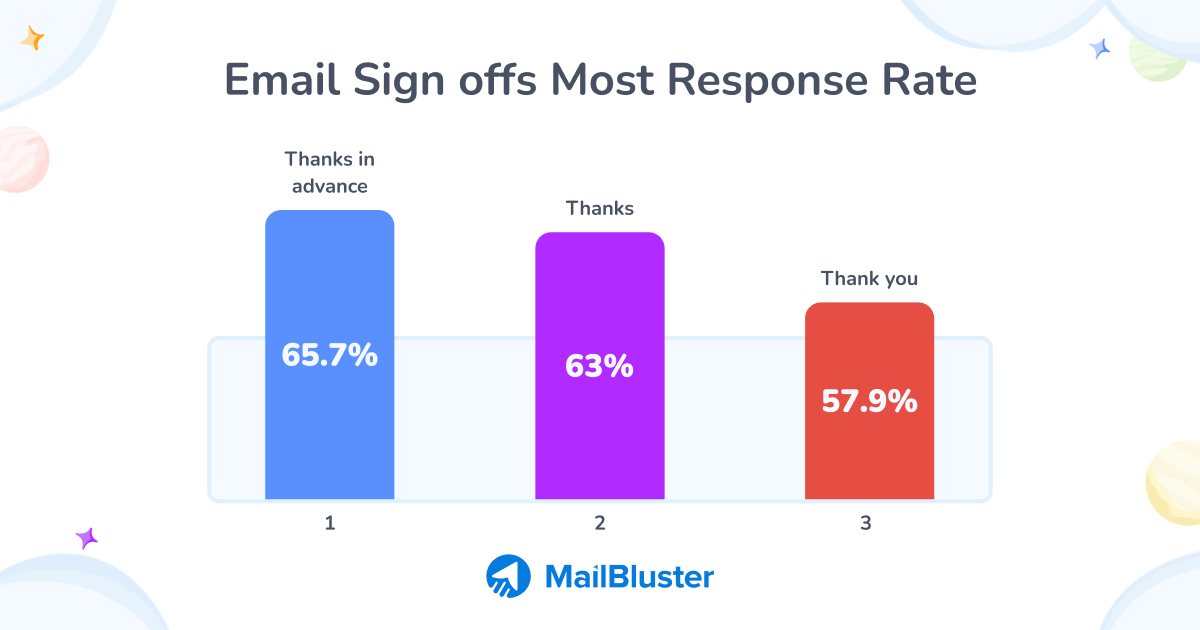
But it doesn’t mean you need to use these 3 email endings only. So, how to sign off an email professionally? We will find out.
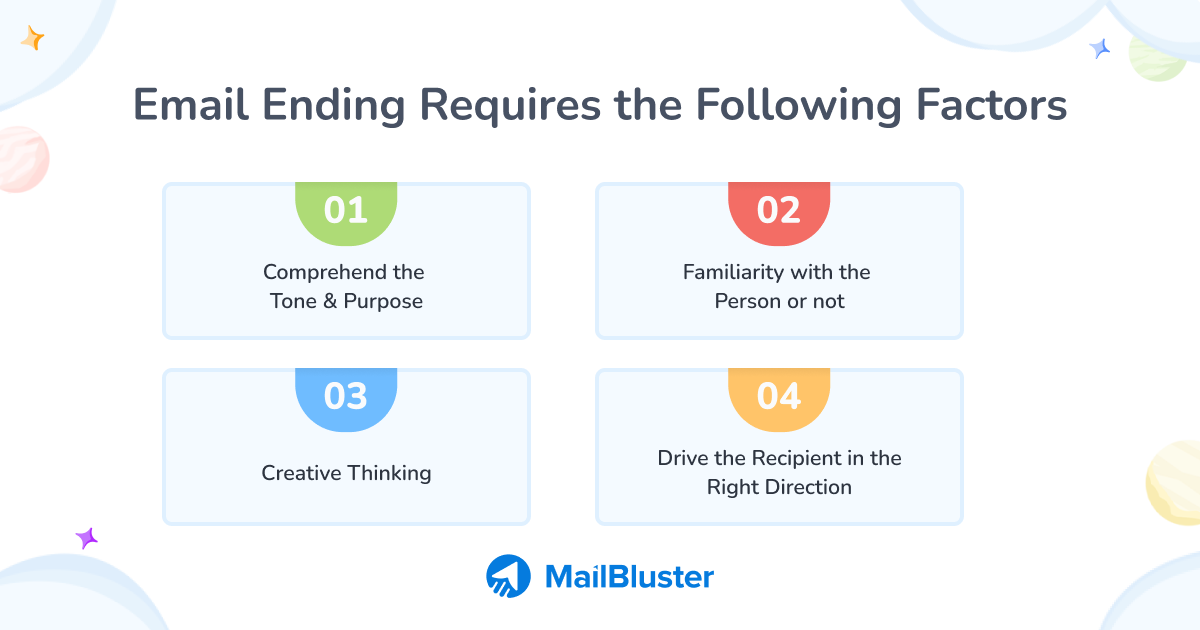
The precise end of an email requires the following factors-
- Comprehend the tone & purpose: Always understand the purpose of the email you are sending. Whether you are sending an important message or official documentation, you need to understand the whole scenario and use the email sign-off in the email.
- Familiarity with the person or not: This is the vital factor that leads you to the kind of email sign-offs you can use here. If you are unfamiliar with the person, carry on with a professional or formal approach.
- Creative thinking: Do not use a similar kind of end email salutation every time. Sit and think about the unique email sign-offs you can use. This will help you get the recipient’s attention and get you a fast reply.
- Drive the recipient in the right direction: When your email is short and simple, use sign-offs that direct users in the right direction. Also, describe your message precisely to let the recipient understand your intent.
For example, ‘’Please let me know if you need anything’’ or “Knock me regarding this matter’’.
Different ways to sign off an email with examples
Finding email ending examples?
Your wait is over. If you want to use an appropriate ending to your email and grow an impression among your recipients, here it is. These email sign-off examples will help you set the right tone for your recipients.
Let’s dive into the email sign offs this time.
Common email sign off examples
Common sign-offs of an email include the formal way of conversation and addressing the sender in a professional manner. The sign-offs here define the casual and informal relationship between the sender and recipient.
Let’s find out some of the examples here-
- Respectfully– This ending phrase is highly respectful and is used most of the time.
- Best– The frequently used phrases in this category
- Regards– Another ending phrase that has the most usage
- All the best– a friendly email sign off and wishing someone well
- Have a great weekend– Friendly addressing someone with a well-wishing weekend
- Looking forward to your feedback– This is the most used phrase when expecting to get a response from the recipient
- Thank you in advance– Casual email sign-off to show your gratitude
- Take care– If you have a good relationship with the recipient
- Thank you for your interest– This is mentioned when expressing gratitude to the recipient.
- Warm regards– This ending expresses gratitude to the recipient; you don’t know well.
Pro-tip: You can use these email closing salutations in different situations. Also, make it more respectful when addressing the recipient.
Professional email sign off examples
Professional email sign offs are more of an official or formal way of ending salutations for emails. The most used professional closings for emails are ‘thank you,’ ‘regards,’‘ sincerely,’ and more.
Find out some more professional ending salutations for emails-
- Kind regards/Best regards– Most-used sign offs in professional emails. Use these salutations to maintain business relations.
- Looking forward to hearing from you– Use this to keep in touch with the recipient and encourage them to reply to your email.
- Looking forward to our next meeting– This closing phrase explains to meet next time in an email conversation and is one of the most-used phrases.
- Awaiting your response– This phrase explains that the sender is waiting for the reply and that the email is urgent.
- Hope this helps– This closing phrase explains the sender assists the recipient with the actions. Further assistance will be provided if needed.
- Sincerely– This versatile form of ending sign states the formal addressing, and following comes the sender’s name.
- Yours faithfully– This salutation is frequently used when the recipient is unknown to the sender.
Pro-tip: Use these phrases according to what the email suggests. Sincerely and best regards email sign-offs are the most common among them.
Informal email sign-offs with examples
This category includes informal ways of interacting with people you have close relationships with. Also, this category includes funny, generational, and passive-aggressive email sign offs. Let’s delve into the different categories of informal email sign-offs.
Informal sign offs for workplace
If you have a close relationship with your coworkers or you are not very much formal with them, use this email sign offs at the workplace.
- Take care– This balances the communication while forwarding the warm message to your coworkers.
- Have a great day, mate! – Probably the most-used form of ending phrase to convey a warm wish.
- Warmest regards/Cheers– That sounds quite friendlier than the other phrases, doesn’t it? You can use this instead of ‘yours truly’ or ‘best regards.’
- Talk to you Soon/See you soon– If you want to communicate and hope to see each other later, use this phrase.
Funny email sign offs with examples
Emails can be fun and humorous as well. When professional and formal email endings are traditional, funny email greetings are the way to express your feelings with a more open-minded approach. Funny email sign offs are similar to friendly email sign offs as well.
Let’s find out some funny ways to sign off an email-
- G2G, Bye– This funny email sign-off is one of the most-used forms in chat especially. But in terms of using a funny ending to an email, this is in the number one spot.
- Stay awesome- This ending phrase is a perfect one to finish your email when you have a close relationship with someone.
- Peace out– This is the casual way to say goodbye to someone, and when you need to express farewell or goodbye in a fun way, use this phrase. Also, use the emoji ✌️ to express this phrase with a visual!
- TTYL– Another short form that is frequently used in chat. Also, frequent use of email to communicate faster. This simple ‘talk to you later’ phrase is a perfect way to convey to the recipient a fun way to end the email.
- See you later, alligator!- A fun way to say goodbye to your recipient. But this expresses more of an “in a while-crocodile” approach.
- May the force be with you- This classic farewell message waves good luck or expresses goodwill to your recipient.
Moreover, the frequently used funny phrases such as Stay frosty, And that’s a wrap, Tag you’re it, Stay real, and more!
Gen Z email sign offs with examples
Gen Z email sign offs generally speak of the reverse traditional way of ending emails. Traditionally, we end an email with Kind regards or Best regards, but Gen Z emails are completely out of traditional touches.
Gen Z email endings specifically imply a closer relationship between sender and recipient. Gen Z emails are very much similar to unhinged email sign offs as well.
Let’s find out some of them-
- Talk soon, loser!– Expressing to meet later and opposite to talk to you later.
- Yours unfaithfully– Showing how email ends with the opposite of faithfully.
- Over and out– Ending email with the opposite of goodbye or farewell.
- Insert pleasantry here– Implying a polite but humorous way to make each other relax.
Besides, ‘That’s all,’ ‘Hehe, bye,’ ‘Please hesitate to reach out,’ ‘Alright alright alright’ are the most used among gen z email sign offs.
Passive aggressive email sign off with examples
Passive-aggressive email endings indicate something that you need to notice at first. Here, the sender indirectly implies something that needs to be comprehended by the recipient. These phrases assist in maintaining a good working environment as well.
Let’s find out some of the passive-aggressive email sign offs-
- Any updates on this? – if email replying takes a long time
- Thanks in advance– It means the recipient must assist the sender
- Correct me if I’m wrong– It means the sender is not wrong here
- All the Best– The conversation is now over (depending on context)
- Please let me know if I misunderstood– Implies the sender is correct here
- I look forward to hearing from you– The sender wants a quick reply
- Just circling back– If the recipient doesn’t answer the email
Pro-tip: Always make sure to timely reply to emails and understand the context of the email and reply.
Different types of email sign offs
If you are looking for email sign-offs for different situations, such as using email sign-offs for special occasions, apologetic, or appreciation, here it is.
Find out different types of email sign-offs below-
Apologetic email sign offs
Composing apology email sign offs should match your email context, and the message clarity is vital. Let’s see some of the apologetic email sign offs-
- Sincerely– This expresses sincerity in making things right.
- Kind regards– A most used form of apology sign off & maintain professionalism
- With regret– Expresses the regrets on events
- Many thanks- Expressing intense gratitude with the apology tone
- My sincere apologies– Directly shows apology to the recipient
Condolences email sign off
Finding a short condolence message to a colleague? Condolence messages require a special touch while expressing sensitivity. Let’s find out some-
- Sending you love and strength– Special message to provide empathy
- Deepest condolences to you and your family– Expressing comfort and sympathy
- Please let me know if you need anything– Depending on the email context, send a condolence email to a coworker with this message.
- I’m here for you if you want to talk– Condolences through conversation
- My heartfelt condolences– Deepest sympathy to the recipient
- Wishing you peace in the days ahead– Expressing sympathy with peace
Appreciation email sign off
Appreciation email sign off refers to giving value to someone’s work. Let’s find out some appreciation email sign offs below-
- I appreciate your understanding- Agreeing and giving acknowledgment email reply
- I appreciate your time- Giving value to provide time on specific work
- Much appreciated- Giving respect to the work done
- Thanks/Thank you for your time– This ending phrase explains gratitude
Email sign offs to avoid
You can realize how essential email sign-offs are at the end of the email. But there are some email sign offs you need to avoid as well. Let’s find out:
- Do not include any deep emotional attachments in emails at the workplace, such as Hugs or Lots of love
- Avoid including political or religious terms in email.
- Refrain from using offensive language.
- Avoid using brief phrases in emails, such as XOXO or Peace.
- Do not include passive-aggressive language at the workplace.
- Using no sign off at all at the end of an email looks unprofessional, so it’s important to include one.
Best practices on email sign offs
Email signing off makes your email more significant and eye-catchy, and this leads you to get the expected reply as well. On the other hand, there are a few things you need to keep in mind while composing emails with sign offs.
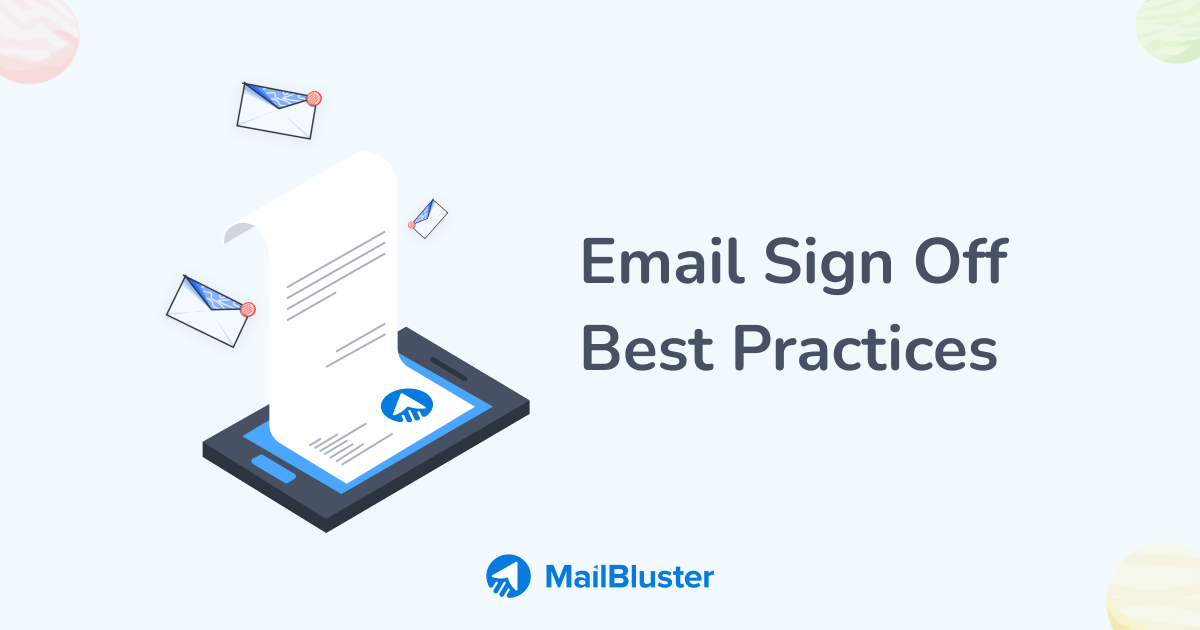
Let’s find out-
Focus on the email body
Understand the email context and what the email body contains. Think about the recipient and the factors to compose the email. Adjust the sign-offs according to the body of the email.
Bring email sign offs with signature
While email sign offs are essential for an email, you should not avoid the signature. The email signature brings more trust and value to the readers and explains who they are interacting with.
These things should appear with email sign offs and signatures:
- Name
- Workplace title
- Contact
- Social account
Connect with the Readers
Readers are the life of emails, and you need to connect with them appropriately to ensure you get a proper reply. Compose your email body, think of the email sign-off, and connect with the readers at the same time. Structure your sign-off based on the relationship you have and will be in the near future.
Email sign off examples
Here are some of the email sign off examples to let you know more about it. Check out-
1. Ends with Best Regards
One of MailBluster’s promotional emails that ends with the Best Regards email sign off. Also, the attractive signature at the end and social contacts make the email more productive and eye-catching to the readers.

2. Ends with Thank you
Another promotional email from the Make team that ends with Thank you. Also, the sender has clearly stated the name and added social contacts at the end to make the email more transparent.
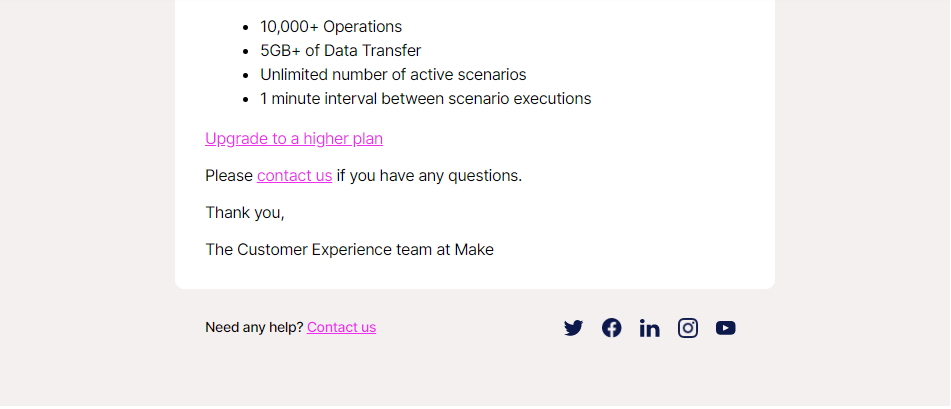
FAQs
- What is the best email sign-off?
Ans: There are quite a few email sign-offs that have been frequently used in emails, such as Best, Thanks, Best regards, Sincerely.
- How do I sign off on a professional email?
Ans: Use sign offs with the tone of the email body, and a professional email needs to end with a more sincere approach. But Regards, Thanks, and Respectfully are mostly used to end a professional email.
- How do I warmly end an email?
Ans: With gratitude, warmly, best wishes, and with appreciation are the warm email sign offs mostly used.
- How to end an email politely?
Ans: Ending email politely requires the sign offs to follow the context of the email body. Use this to end the email: Thank you, Best regards, Respectfully, All the best.
Wrap up
Composing email sign off is profoundly dependent on the industry, how the sender and recipient are connected, and the context of the email.
Our comprehensive email sign offs show which industry you can add any specific ending to and also the most preferable and good ways to end an email. Use the one that fits in well within your context. Also, send email with an appropriate email marketing tool and follow email regulations to get more impressive results.


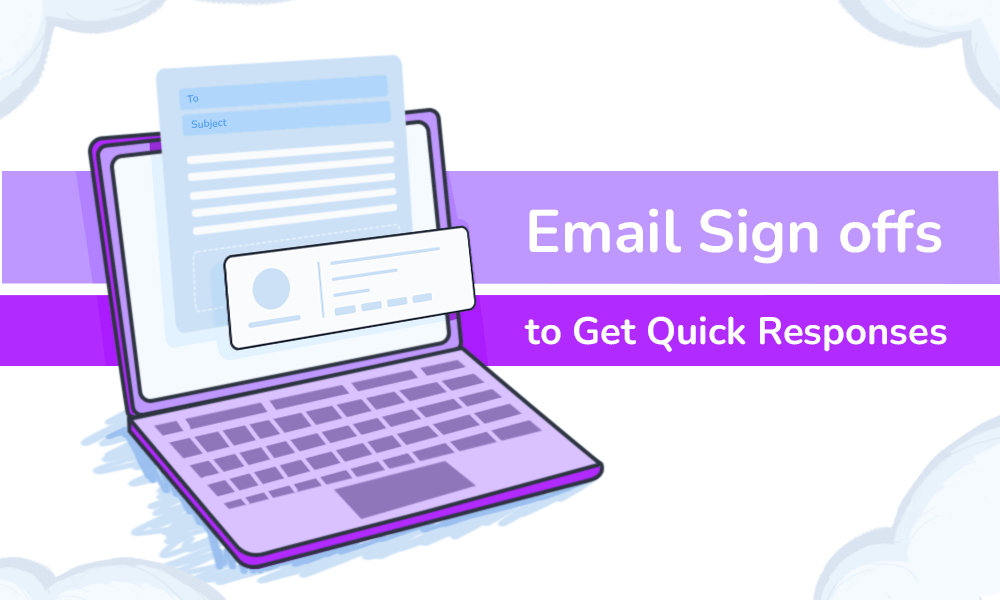
 Contents
Contents

Really liked this article. It explains why email sign=offs matter in a clear and practical way. The examples are easy to understand and helpful for different situations. The part about sign-offs to avoid was a great reminder too. Nice work putting this together.
Very informative read. Your explanation cleared up my confusion.!